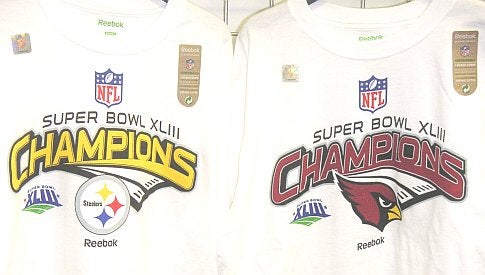A Greener Bowl
Four eco-friendly initiatives at the big game

On the surface, the only thing green about the Super Bowl is the 95,000 square feet of brand new turf (at a cost of $85,000) they require to be brought into the host of the big game (okay, come to think of it, that’s not very green at all). But, the NFL is doing what they can to give the appearance of being a neutral event in the decaying of our environment.
Green Shirts
From Roethlisberger to Tomlin, oversized championship T-shirts are on the field before the MVP can say he’s heading to Disney World. But this year Reebok’s shirts are “greener” than normal, despite the prominence of black and gold. The shirts are made from 100-percent organic cotton fabric with hangtags made from recycled material. Not a bad attempt but making twice the shirts necessary (an equal amount were made in case of a Cardinals victory) isn’t exactly a model of conservation. Where do the other half go? Hopefully the kids in Nicaragua (or the chosen country this year) will appreciate how green their new shirts are.
Renewable Energy
Both the Super Bowl and the five-day NFL Experience extravaganza were powered by renewable energy purchased by the Tampa Electric Company from TECO. The league will actually pay $5,000 more to go green, but the PR is worth it. TECO gets its power from solar panels and a biomass facility in South Florida. Estimate put the CO2 savings at around 313,000 pounds — the equivalent of taking 19 cars off the road for a year.
Trees
Nothing says green like planting some trees. The NFL planted more than 2,700 trees at 12 sites across the Tampa area. Fifth- and sixth-grade kids helped plant 400 along the McKay Creek Greenway. While the tree progam isn’t new, a long-term program has been initiated to monitor the environmental impact of the planting. The U.S. Forest Service will use software to quantiy the greenhouse gas impact. StubHub, the prominent online ticket broker, even did its part by promising to plant a tree for every playoff and Super Bowl ticket purchased through the website. With a 15 percent commission on each $900 ticket sold to a lifelong Steelers fan (pronounced “stillahs”) traveling from Newton, Massachusetts, those better be some freaking redwoods.
Leftovers
The Super Bowl is known for its excess, and with excess comes leftovers. From food, to building materials, to decoration and office equipment, all extras will be donated to nonprofits after the game. The nonprofits can either use the stuff or sell it at auction (we’re guessing the aforementioned fan would pay a fortune for pencils that Tomlin used). The overall value of the donations is estimated at $300,000.